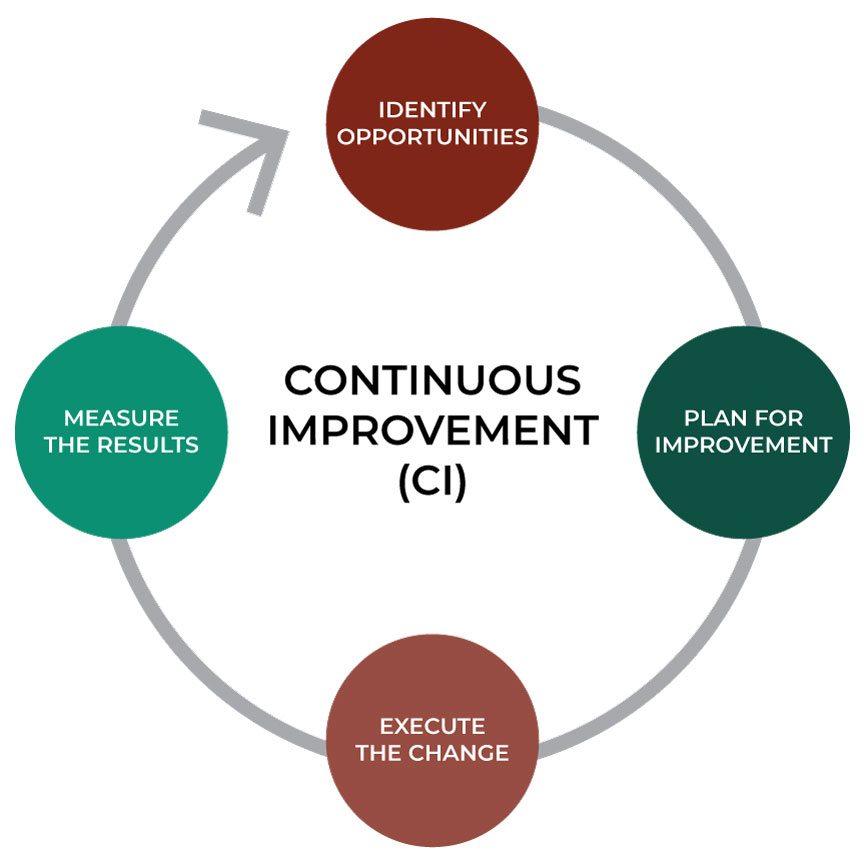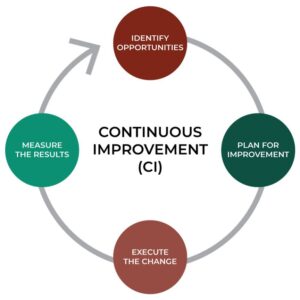
With the pace of change in today’s business climate, organizations that adopt Continuous Improvement (CI) can use it as a tool to stay ahead of the competition and keep employees engaged. According to Google, a common search phrase is “what is meant by continuous improvement in business”. Wikipedia defines the answer to this search as “A continual improvement process, (abbreviated as CI), is an ongoing effort to improve products, services, or processes. … Improvement in business strategy, business results, customer, employee and supplier relationships can be subject to continual improvement.”
While this is a serviceable definition, the answer doesn’t really get to the heart of continuous improvement. Those organizations thinking of it only as a process often fail in their attempt at implementing it. Why? Because continuous improvement is more than a process. It is a mindset. Continuous improvement is the practice of always looking for opportunities for change—not just for the sake of change—but for the purpose of producing better outcomes for the entire organization and their customers.
For business leaders, that mindset means sharing a customer-driven vision, challenge, or goal, and using ideas from anywhere in their organization to make things better to meet that challenge. For employees, that means feeling empowered to share these ideas and experiment to align their ideas and support the company/customers goal. Organizations that adopt this way of thinking find that changing that first thing allows the team to view things differently and see the next improvement that needs to be addressed.
For example, in manufacturing, it is often the case that a program will be implemented on the manufacturing floor to increase production. But, once that project is complete, organizations find that the entire company needs to become more responsive to handle the increased speed of production. This example shows how fixing one thing allows an organization to identify the next improvement.
Continuous Improvement (CI) Terminology
While it is important not to get hung up on terminology, it is helpful to have a general understanding of some of the key language used in continuous improvement.
Value Added – Any activity that increases the market form or function of the product or service. (These are things the customer is willing to pay for.)
Non-value added – Any activity that does not add market form or function or is not necessary. (These activities should be eliminated, simplified, reduced)
Continuous flow – movement of material and information through the process without stopping.
For more terms, the Washington State Department of Social and Health Services offers a robust Glossary of CI Terms.
Organizations that are looking to continuous improvement as a traditional time-bound project to fix one small problem eventually end up abandoning it. Don’t let this be you – contact VMEC today, we can help – [email protected].
Continuous Improvement Can Apply to Every Organization
Continuous improvement can be applied to any organization that requires people to move material or information through steps. In other words—any organization. Not for profits, educational, governmental and financial institutions, healthcare organizations and manufacturers can all use continuous improvement for better results. For example:
- A financial institution who can remove waste may be able to remove fees to become more competitive
- An operating room team that goes through the exercise of ensuring everything is in the right place, at the right time will reduce delays, leading to reduced risk and better patient outcomes
- A manufacturer using continuous improvement can identify where delays exist in their organization and cut time from production to increase productivity (hint: 60-70% of the time the delays aren’t on the manufacturing floor)
These are just a few examples of how continuous improvement can work for any organization, but the applications are endless. Any organization that needs to stay competitive, engage employees, leverage underutilized resources, meet customer challenges, better manage inventory or information and/or improve time to market can leverage a continuous improvement mindset.
Getting Started with Continuous Improvement—Do’s and Don’ts
There are two important points that organizations need to understand when implementing continuous improvement:
- While it can—and often does—start as a program, to be most effective continuous improvement should become the culture within the organization.
- The entire business needs to be involved in this culture from the top down.
Four Common Mistakes Organizations Make While Implementing Continuous Improvement
Organizations sometimes decide to try continuous improvement and give up too soon. Some of the common mistakes they make are:
- They just do it. Organizations that treat continuous improvement as a program (without senior leadership involvement) to fix one small area find that the fix isn’t sustainable. Without a common language across the organization and standard training people are just expected to “figure it out”.
- They take a cookie cutter approach. Organizations looking to do what their friends or competitors do will find that it doesn’t work for their company because every organization has different problems and goals.
- One person is designated to lead. Appointing one continuous improvement champion who’s trying to get the entire organization to change doesn’t work. Without champions throughout the organization, consistent training and a common language, continuous improvement efforts often fall flat.
- Leaders don’t understand their roles as coaches. In a CI culture, a leader’s responsibility is to coach their staff to develop everyone in the organization into a problem solver.
Four Factors for Continuous Improvement Success
While it can feel overwhelming to implement a program that never really ends, there are some core concepts that organizations can use in order to make continuous improvement effective and sustainable.
- Ensure there is alignment and vision from the top down. While metrics are important, continuous improvement is about more than measurement. Take the time to instill a common vision throughout the entire organization.
- Start small. As long as everyone is aligned to the vision, an organization can start small with a test. Find the early adopters who are willing to take the lead and change the culture over time.
- Don’t be afraid to fail. One of the hardest things for organizations to do is change their mindset to accept failure as a learning opportunity. If organizations start small, they can fail fast and fail cheap until they feel confident in their approach.
- Determine what to measure. Every organization has different goals and challenges so defining success is critical.
Organizations that instill a common vision throughout the company have a greater chance of successfully implementing continuous improvement.
The Benefits of Adopting a Continuous Improvement Approach
Clayton Taylor, Management Research Analyst, Pr. and Certified Six Sigma Master Black Belt at Arizona State University, shares “Implementing a culture of continuous improvement helps an organization by giving it the people, the processes and the tools needed to provide services in a way they were not capable of previously; and allows them to do so at a level that easily meets or exceeds the majority of their customers’ expectations. It also gives the organization the capacity to serve a larger number of customers and expand their services beyond their existing capability.”
Depending on their goals, organizations that adapt to this shift in thinking can see:
- Improvements in quality
- Reduced lead and process time
- Improved morale
- Better employee engagement
- Reduced staff turnover
- Increased capacity
- Higher quality
- Growth by providing additional services or capabilities
Engaging with VMEC for Continuous Improvement
Traditionally organizations contact VMEC when leaders and employees are looking to implement continuous improvement OR when leadership is interested but employees are not yet aligned. These companies are often concerned about the level of effort in implementing continuous improvement, so they engage VMEC to start with one area.
While other consulting organizations may tell organizations what to do and then leave them with a document, the VMEC approach is more guided. VMEC talks to companies about their challenges and uses tools to identify where unknown problems exist. From there, VMEC teaches them how to resolve those issues themselves through a customized approach to training, tools, communication and problem solving. By finding and developing internal champions within the organization, VMEC makes sure that when the engagement is done, the organization can continue to use continuous improvement.
VMEC has helped teams from product development, sales, design, manufacturing, customer service, technical service and finance implement:
- Faster market response
- More competitive lead times
- Faster shipments
- Avoided costs
- More output with the same staff
- Increased profit sharing
- Better control and understanding
- Control of space and inventory
A Spotlight on Continuous Improvement Success
Appalachian Flooring has been producing hardwood flooring at their main facility in Cowansville, Quebec since 2000. Recognizing the growing market for engineered floors, in 2012 the company built a new engineered floors manufacturing facility in North Troy, Vermont. Operating as a startup, the team in North Troy began by defining a culture of respect with shared core values.
With the culture defined and knowing the team had to produce quickly with limited resources, Jennifer Fraser, General Manager knew she wanted to implement a similar program but didn’t know exactly where to begin. That’s when she contacted VMEC to help.
“We had ideas, but didn’t know where to start,” said Fraser. “VMEC came in and helped us get on the right path. They looked at what we wanted to do and helped us evaluate it through the lens of investment vs. payback. They also brought us additional ideas that weren’t on our radar. We really felt that VMEC wanted us to succeed and learn how to do it on our own.”
Starting with low hanging fruit such as visual cues, changeovers, value added tasks and inventory, the results of the program were immediate. Within 10 months Appalachian Engineered Flooring was stocking 50% less inventory and seeing a 24% increase in sales on a monthly basis because they were producing the right products at the right time. By focusing on the goal of no defects at the end of the line, they were able to increase production 29% without a capital investment.
The team also changed decision-making tools to look at cash flow rather than a traditional accounting model. This allowed them to put $1million in cash back into the company every year to gear up for expansion in their rapidly growing industry.
Fraser believes that continuous improvement is the new normal for businesses and that the more traditional structures are actually at greater risk because of the pace of change in today’s markets. By using continuous improvement, Appalachian Engineered Flooring has been able to enable their people to make decisions and understand when they make mistakes. Doing this has freed up the management team to grow the business. The results have been so significant that the original plant in Quebec has revamped their continuous improvement program.
In this new normal, there’s always change and VMEC is still there to help. Fraser says “Even though we’re not in a current engagement, VMEC always touches base to check how we’re doing and to make sure everything is going well. I always tell other manufacturers about VMEC. I want to see American manufacturers compete and win and VMEC can help them do that.”
About VMEC
VMEC has helped over 900 manufacturers and countless not for profits, healthcare organizations and financial, educational and governmental institutions to attract and retain employees, save time and money and grow with Continuous Improvement (CI). Contact us to learn how we can help your organization.
Posted: April 2018
